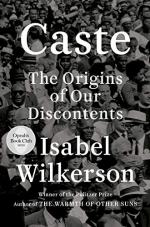|
This section contains 702 words (approx. 2 pages at 400 words per page) |

|
Caste: The Origins of Our Discontents Summary & Study Guide Description
Caste: The Origins of Our Discontents Summary & Study Guide includes comprehensive information and analysis to help you understand the book. This study guide contains the following sections:
This detailed literature summary also contains Topics for Discussion on Caste: The Origins of Our Discontents by Isabel Wilkerson.
The following version of this book was used to create the guide: Wilkerson, Isabel. Caste: The Origins of Our Discontents. Random House, 2020.
Toxic pathogens from World War II were thawed in Siberia in 2016 due to an intense heatwave. Wilkerson compares these toxins to hatred in the human heart, which does not disappear, but lies in wait.
She discusses the modern tensions and issues in America, which cause people to question how American changed so quickly. She notes that looking back to America’s origin, its creation of a country based on a caste hierarchy causes issues which have yet to be addressed, explaining many of today’s problems. Early settlers created a caste system that said white people were the dominant caste, and black people were the subordinate caste in order to justify enslaving African captives. The terms “white” and “black” were blanket terms created for this system, to distinguish castes and suggest the superiority of most Europeans.
While America’s caste system uses race as its distinguisher, caste does not have to. Wilkerson distinguishes from race and caste: caste is the social structure based on learned assumptions regarding race, race is whatever the caste system determines it is. Wilkerson notes India’s millennia old caste system is based on the village their family is from. Nazi Germany is another recognized caste system, where the Aryans were the dominant caste and Jews the subordinate.
Wilkerson goes over what she has determined to be the eight pillars of caste: the divine will and the laws of nature, heritability, endogamy and control of mating, purity vs pollution, occupational hierarchy, dehumanization and stigma, terror as enforcement, inherited superiority and inferiority.
Wilkerson then describes the tentacles of caste, shows the psychological effects of people in a caste hierarchy. Wilkerson calls caste a performance, as caste hierarchy provides people with a script to follow based on their race. The system rewards those who follow the script, and punishes those who stray from it. These scripts harm the dominant caste, too, by forcing them into dominating and leadership roles, even when unsuited. The script also creates a false scarcity of success for the subordinate caste, creating false rivalry between them.
Caste causes a phenomenon called “dominant group status threat” by political scientists, where the dominant caste perceives any successes of lower castes a threat to their own success, which heightens the divide between castes. Caste creates narcissism in the dominant caste, who live with delusions of false superiority.
The lowest caste is forced to empathize with the dominant caste for their own survival, even when they are the victims. Success of the lowest caste undermines the hierarchy, so is met with great resistance, and studies shows those subordinate caste who stray the most from their assigned role face the greatest stress.
Caste negatively affects the health of all members of its hierarchy. Studies have shown that caste causes many healthy problems in African Americans, as Africans do not have the same rates of disease as their American counterparts. As well, harboring prejudice worsens the health of the dominant caste, as the hatred causes their bodies to perceive threat when interacting with subordinate caste which puts stress on their hearts.
Wilkerson talks about the conditions which led to Barack Obama’s election, the greatest departure from the caste system in America’s history, and the backlash from his presidency. Obama was extremely qualified with a very intelligent wife, and ran a flawless campaign, while his opponent chose a questionable vice president. Despite his election, anti-black sentiment actually rose in America’s white population, who largely did not vote for Obama.
Obama’s election caused many white people to worry that their whiteness was in jeopardy, and that they were losing their superiority of the country. This caused voters to vote for Donald Trump, who was not qualified, but promoted white supremacy.
Wilkerson concludes the book by saying her reason for writing it was not to solve all caste’s problems, but to explicitly reveal them, to awaken her audience. Once awakened to caste, it is our responsibility to act against the assumptions of caste, to bear responsibility for how we treat others, and to build human connection.
Read more from the Study Guide
|
This section contains 702 words (approx. 2 pages at 400 words per page) |

|



